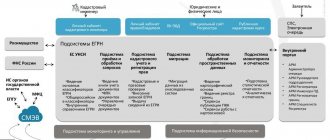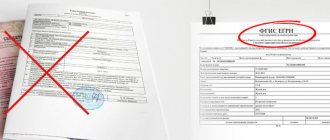Availability of housing for a person is an important condition for his normal existence. The real estate objects that the State Committee is interested in include: premises, buildings, land. Consequently, information about the structure and functions of this institution may be useful for every resident of the country.
You can start with what GKN is and what this abbreviation means.
EGRN AND GKN Differences
At the State Property Committee you can obtain a cadastral passport with all the information on real estate.
There is no data on ownership rights or purchase and sale transactions in the State Property Committee. At your request, the State Property Committee will provide a cadastral passport, an extract containing information on the property, and a site plan. The Unified State Register provides information of a legal nature: ownership of real estate and all operations carried out on objects over the past period.
The extracts differ in that one is a certificate of real estate, and the second is a legal document. When concluding any real estate transaction, you must obtain both statements. The State Property Committee will confirm the availability of real estate in a specific territory and indicate all the technical characteristics of the object. The Unified State Register will inform you about the owners of real estate, their number and form of ownership, and possible encumbrances.
The cost of obtaining an extract depends on the person requesting it.
Receipt procedure
You can obtain information from the State Property Committee by contacting Rosreestr or the MFC.
Extracts
The application is submitted on paper or electronically (using the official website of the structure). The document contains only the information requested. The issuance of an extract requires payment, and a certificate of cadastral value will cost the applicant free of charge.
An extract from the Unified State Register, disclosing issues of legal ownership in relation to real estate, will be a document that is necessary in the event of transactions with such (sale, etc.). In order to receive it, the applicant can contact Rosreestr, MFC, or the government services portal. You must indicate the purpose of obtaining information and pay the state fee.
You can receive an extract in person or through a representative. The second option requires the presence of a properly executed power of attorney.
Cadastral passport
A document containing the most important characteristics of the object can be obtained from Rosreestr, MFC. Also, the territorial department of the BTI can provide issuance.
A cadastral passport can only be issued to the owner of the property based on the provided identification document - a passport, and sometimes SNILS.
What information does the State Property Committee contain?
It is impossible to call cadastral registration of real estate any special innovation for Russia. Similar measures have been taken before.
Normative base
GKN information is taken into account on the basis of the provisions of the Constitution, codes of the Russian Federation (Civil, Forestry, Urban Planning, Housing, Water), as well as other regulations, for example, more active work on collecting and systematizing information began to be carried out after the adoption of Federal Law No. 221-FZ on July 24, 2007 “On the State Real Estate Cadastre”, which regulates, among other things, the recording of information in the State Property Committee database.
Objects
The cadastre is based on information about land resources. It contains information about the state borders of the Russian Federation (external and internal), specially protected areas, and pipeline networks.
Accounting objects include:
- buildings and premises;
- plots of land;
- objects of unfinished construction.
Only real estate located in Russia is taken into account.
Principles of conduct
A unified technology is used to account for objects throughout the Russian Federation.
The principles of maintaining the State Control Committee can be expressed as follows:
- comparability of data entered into the state cadastre with other information (information databases);
- keeping data up to date;
- openness of information.
Information from the State Property Committee can be obtained by anyone who is interested in it, that is, any person. The exception is data containing secrets that are protected by law. The network of MFCs (multifunctional centers), which are present in many large cities, simplifies the process of obtaining information for citizens.
Authorized body
UFRS - the decoding of this abbreviation looks like this: Office of the Federal Registration Service. The institution has been reformed. Instead, a structure was created called the Office of the Federal Service for State Registration, Cadastre and Cartography. There is a short name for it: Rosreestr.
We note the following: if until the beginning of 2021 the State Property Committee was a separate institution, then from that moment it resumed its activities as part of the Unified State Register of Real Estate (USRN). The information bases of the Unified State Register and State Property Committee, which previously operated independently of each other, were merged. Now they are under the control of Rosreestr.
This is the executive structure that is responsible for keeping records of objects and providing information. In addition to responsibilities for state registration of real estate and transactions with it, this body resolves issues of cartography and geodesy.
Registry structure
The State Control Code has three main sections.
Structure:
- A real estate register is a systematic list of property data.
- The cadastral files section contains information about those documents on the basis of which data was entered into the information base.
- Cadastral maps are diagrams of land plots designed to reproduce information about objects in text and graphic descriptions.
Information resource
The State Property Committee contains an extensive database of information containing unique and complementary characteristics of real estate.
The first include:
- type of object (plot of land, house, premises, unfinished construction site);
- cadastral number, date of registration in the State Property Committee database;
- information regarding its boundaries.
For a room there is information about the number of the building in which it is located, the floor and a description of its location. The area of real estate is required to be specified.
The list of additional information includes:
- the address of the object and the number assigned to it previously;
- information regarding rights to the object;
- information about the owners, which includes information about the postal address or email address of the owner;
- information about encumbrances;
- information on cadastral value.
Of particular importance is that the category of land and the permitted use of the site are indicated.
For a house, in addition to its purpose, you can additionally find out the number of floors and the material used for the external walls, and the cadastral number of the plot on which it was built.
If the object of registration is a land territory, then the cadastral numbers of the buildings present on it (if any) will be indicated.
How to obtain information from the State Property Committee?
Information about real estate can be public, publicly available, provided at the request of all citizens, and data with limited access. The first contain general information about the object, the second - information of particular value (for example, data on organizations having encumbrance rights).
Public information can be obtained in the form of written statements using electronic services.
Required documents
All citizens can obtain data from the State Property Committee. Federal legislation establishes restrictions on open access to information contained in the State Property Committee.
Often, information from the State Property Committee is requested in situations of legal proceedings.
The procedure for providing information included in the State Property Committee
Officially, there are now several forms of obtaining data from the State Control Committee:
- Cadastral passport, which is an extract from the cadastre
It specifies the criteria for an object necessary to perform significant actions with it (purchase, sale). A passport is required for users when verifying the authenticity of object criteria in administrative documents.
- Extract from the Unified State Register of Real Estate
It includes all extended information about the object. A citizen can indicate in the request the data that he would like to see in the extract. An extract is required when preparing official certificates of land surveying and carrying out work by cadastral specialists. It contains data on the boundaries of land plots, extended addresses of owners, data on plots bordering the main objects. The cadastral extract is paid, but it is ordered by buyers and sellers of property more often than other forms of data.
- Territory plan
It consists of two sections: text and drawing. The first includes information about all territories, their areas, boundaries, cadastral numbers, and their location on the ground. The second section contains an image of a limited block with buildings located on it. A plan is needed when carrying out cadastral work. As a rule, it is provided on a paid basis.
- Certificate of value of the property from the real estate register
It includes information about the number and cost of the property. Based on the certificate, the tax fee is calculated when applying for a loan, opening an inheritance case, or when buying or selling an object. Most often, this type of request is used to protect property rights in the courts.
- Copies of documents used when entering information into the real estate register.
Online on the Rosreestr website
In the age of modern technology and the insanely busy population, people try to get all the data they need in real time, without going to stationary centers and without wasting precious personal time, standing in queues and waiting for a specialist who can answer the question. An extract from the State Tax Committee can be ordered on the Rosreestr website.
To obtain the required information, do the following:
- Go to the portal.
- View the list of services offered.
- Order an extract in the required format.
The defining data of the object and the existing ownership rights to the property can be viewed in the USRN extract. If a person needs data on the cost reflected in the Unified State Register of Real Estate, then he needs to ask for the appropriate certificate.
Postal and personal appeal
If a person does not have the opportunity or desire to receive the service in real time, then he can obtain information in other ways:
- It is possible to personally come to the territorial office of Rosreestr, the center for the provision of public services, and fill out a request.
- You can send a request to the real estate registration authority at the place of territorial location of the property, at its location via Russian Post. The letter must indicate the registration number, extended address of the object, type, form of data provided, and method of receiving a response. Any citizen who is the owner of a property or a representative of the owner can take advantage of this by obtaining data.
Cost of obtaining information from the State Tax Committee
Some forms of providing data from the State Property Committee are provided free of charge (information and cadastral value), and some only on a paid basis (cadastral plan).
What is the cost of obtaining a cadastral extract about other information regarding a property is presented in the table below:
| Written form, rub. | Electronic view, rub. | |
| For citizens | 400 | 150 |
| For companies | 1200 | 300 |
Cadastral information published in public maps is publicly available and no person or representative of an organization is charged for viewing it.
Deadlines for submission and relevance
Cadastral information is always urgently needed, because purchases and sales of property objects depend on their correct reflection. The time period for processing the request is no more than five working days from the date of submission of the request from the interested party. Cadastral plans are completed a little longer, within fifteen working days.
Transactions with property objects are often disputed in the course of judicial proceedings, therefore, when making them, it is necessary to always have reliable information with you, so as not to participate in further property disputes and not waste personal time on this.
The GKN database was created for systematic accounting of real estate assets. Data from the State Property Committee is necessary for people when conducting transactions for the acquisition or sale of real estate, registering rights to them, and conducting land surveying procedures.
Alteration
Cadastral data is verified every 5 years. Information regarding extracts from the Unified State Register can be changed the next day after submitting the application.
In other words, the likelihood that while a citizen is waiting for documents, the owner of the property will change is very high.
It must be remembered that from the beginning of the new year a new federal law regulating the procedure for state registration of real estate comes into force.
According to the new law, cadastral registration and state registration of real estate rights will be combined into a single accounting system.
Currently, the cadastral chamber and Rosreestr operate in a separate mode. Therefore, the question of their optimization arose a long time ago.
Starting this year, documents confirming real estate transactions are issued by only one structure.
This format is convenient not only for citizens and legal entities, but also for the regulatory and registration authorities themselves.
Drawing up papers in one structure allows you to:
| Speed up the registration procedure | and issuance of documents |
| Simplify the procedure for receiving | necessary information about real estate objects |
Many large cities have already been able to appreciate the benefits of created and open multifunctional centers, which allow them to avoid long queues and, accordingly, wasting time.
Starting from the new year, certificates of ownership for various types of real estate will be cancelled.
In addition, the procedures for registering property rights and registering objects with cadastral records will be subject to the merger.
Registration of all documents will take from 9 to 12 days.
Confirmation of real estate registration will be an extract from the Unified State Register of Real Estate. There will be a merger of the current State Control Committees and the Unified State Register.
Thus, instead of two registration procedures, only one will be officially carried out.
This combination of the database will solve the problem of technical errors and duplication of data.
The merger of the State Property Committee and the Unified State Register has certain pros and cons:
| Since all information will be stored on an electronic resource | then the necessary information can be obtained instantly |
| The “one window” system will simplify the procedure for obtaining statements and certificates | as well as all state registration |
| Applicants will be able to submit documents to any branch of Rosreestr | no matter where the property is located |
| Significantly simplifies the paper submission procedure | legal entities will be able not to provide constituent papers, and the documents will be refused acceptance only if the registrar cannot establish the identity of the applicant |
| The time frame for registration and registration of rights will be reduced | 5 and 7 working days, when carrying out two procedures at once the period will be up to 10 working days and when submitting papers through the MFC, the period will be from 9 to 12 days |
What's relevant today
Today, the Unified State Register of Real Estate and the State Property Committee have been combined into the Unified State Register of Real Estate (USRRN), which is maintained entirely electronically (with the exception of cases that include applications for entering data into the database).
This means that now, in order to obtain cadastral or title information, you must contact the same body - Rosreestr. At the same time, you can submit requests, as before, through the Multifunctional Centers. Thus, the government has simplified the work of government agencies, as well as citizens, who no longer need to contact two different institutions and prepare two sets of documents. The amount of state duty for the provision of services remains the same.
In addition, now, instead of certificates certifying ownership of real estate and similar extracts from the Unified State Register, title extracts from the Unified State Register are issued. At the same time, information statements are also issued, of which there are now several types. When submitting your application, it is important to indicate which transcript is required.
Legal statements have no expiration date, informational statements do not have a regulated period of validity. Each structure requesting such a document sets its own time frame, usually from two weeks to one month. However, it is worth understanding that the relevance of the information received remains as of the date of issue of the document. In fact, changes can be made to the database the very next day.
Previous rules for obtaining documents
If we consider the extract received from the Unified State Register, it has a record structure, visually drawn up in the form of a register. This is a unified document; its form is identical throughout Russia. At the same time, extracts, which previously were only informational in nature, some time ago, without losing this function, began to be issued to citizens instead of certificates that confirm ownership rights. Those owners who received such a document instead of a certificate should know that it is unlimited and has the same legal force as any other title document
From a legal point of view, the same important document is the cadastral passport, which is involved in concluding any real estate transaction.
Obtaining information from the Unified State Register and the State Tax Committee is equally easy. The algorithm of actions is simple and does not require the preparation of a large list of documents.
The situation is somewhat different with obtaining a cadastral passport, which only the owner of the property or his authorized representative has the right to receive. Previously, this was done by the Bureau of Technical Control, then by the Cadastral Chamber, and today by Rosreestr. As an alternative, you can contact the territorial Multifunctional Center for the same purpose.
Convenience for citizens
The main benefit for citizens from the changes is the real estate transactions
Firstly, from now on, to submit documents for a transaction for registration,
it is not necessary to personally go to the Rosreestr department or the nearest multifunctional center for the provision of state and municipal services.
You can do everything via the Internet, using the appropriate functionality of the Rosreestr website or the government services portal. Although for those who want to submit documents the old fashioned way, this option remains available. Secondly, the geographical reference to the location of the transaction that existed before is now lost. Now a transaction for the alienation of an apartment or a plot of land located, for example, in the Far East, can be registered by submitting documents in Moscow, Belgorod or, say, Kaliningrad. Likewise and vice versa.
At the same time, for state registration of property rights to real estate is being reduced In particular, the obligation to present constituent documents to representatives of legal entities is canceled. Rosreestr employees will be able to access this documentation independently.
No less good news for property owners was the reduction in the deadlines allotted for registration actions. Now, when submitting documents directly to the Rosreestr department, you will have to wait no more than 10 days for the result. When applying through the multifunctional center, you will need to wait a little longer - up to 12.
Briefly summarizing, with the transition to the Unified State Register of Real Estate:
- registration of real estate transactions has been simplified;
- the procedure has acquired an extraterritorial character;
- the list of documents for registering property rights to real estate has been reduced;
- Registration times have been reduced.
Main Differences
The need to obtain cadastral information arises when it is necessary to clarify or confirm the basic characteristics of real estate.
The extract from the Unified State Register does not provide such information. From it you can find out who is the owner of the object, whether there are co-owners and who, who can lay claim to the property and other answers related to the right of ownership. It can be noted that the Unified State Register and the State Property Committee were initially independent of each other. Different bodies were in charge of maintaining the databases; therefore, to obtain extracts and passports, it was necessary to contact different government agencies. These institutions systematized information and kept records of it regarding real estate.
In the State Property Committee and the Unified State Register, the difference lies precisely in what information they deal with and what data citizens can obtain from them. As mentioned above, the cadastre issues passports with information about the most important technical characteristics, extracts about registered objects and their liquidation, as well as general documents - territorial plans.
Rosreestr, which previously issued extracts from the Unified State Register, collects, stores and processes information about existing, newly registered, terminated property rights, arrests, encumbrances and other restrictions.
What applies to GKN objects?
Such objects are all land plots that make up the territory of the Russian Federation. In addition, all immovable objects of a property nature are subject to registration by this state body for the period of their registration. Each of them, as a rule, is owned by an individual or legal entity, enterprise (organization), land committee or administration (or federal self-government body).
Data related to each specified object should be stored in two formats at once - paper and digital. Each real estate unit has its own unique cadastral number. It is from this that you can easily determine the owner of the object and its location. Information is issued to citizens and all interested parties in accordance with the approved form for requesting information from the State Committee for Taxation.
How to correctly extract from the Unified State Register or Unified State Register
EGRP-ALL is a company that specializes in providing extracts from the Unified State Register of Real Estate. Getting the service is simple - fill out the form, pay a fee and receive a statement by email. This service is absolutely legal. Working closely with our partners, we always provide up-to-date information in the shortest possible time and at an affordable price. This will allow you to protect yourself from suspicious real estate properties and unscrupulous owners. We have been working for 2 years and during this time we have helped many people. We try to ensure that you are satisfied with the service you receive, because your success is our success.
This extract will allow you to find out the LAST NAME, FIRST NAME and PATRONIC name of the owner of the property. If the owner is a legal entity, you will find out its name and details. You will know: whether the property is rented out; is there a MORTGAGE; whether the court imposed an ARREST or any other encumbrances.
19 Jul 2021 glavurist 157
GKN information resource
It works on the Rosreestr website. Since its launch in 2015, it has proven its worth as it provides many benefits. Here are just some of them:
- Very fast search - the data will be on the screen in a couple of minutes;
- Uninterrupted 24/7 operation;
- Possibility of remotely receiving information by email;
- Obtaining information about the cadastral number and category, area and other data, having only the address of the object;
- Relatively reasonable price for the service.
Since the information is updated every five years, it is important to check that the GKN information is current. By the way, if a person took an extract, say, a year ago, but the state, according to plan, re-evaluated it and entered new data into the State Tax Code, then the document will have to be taken again, because the previous version is already outdated and cannot be used in court or anywhere.
There are some inconveniences associated with this, but thanks to the GKN information resource, they can be resolved much faster than before.
Extract from the Unified State Register
The state is a single harmonious system, which would not be integral if at least one link did not work correctly. Thus, to conduct real estate transactions, citizens need to contact authorized government bodies that keep strict records of all real estate properties. Previously, in order to complete the purchase and sale of property, it was necessary to obtain a certificate from the Unified State Register, but today the situation has changed dramatically, and an extract from the Unified State Register is already required. We will now figure out how not to get confused and collect the correct package of documents.
Another point is that it is impossible to order schematic images in electronic form. If cadastral plans, land boundaries and land surveying are needed, then you will only have to contact the organization in person. All schematic images have already been entered into the database and can be provided to interested parties.
Types of State Tax Code information
After contacting the State Committee for Taxation, a person receives information in a certain form. There are several main forms in which it is customary to provide data - a cadastral extract and a cadastral passport.
The cadastral passport contains information about the unique characteristics, as well as information that will be needed to register the property.
When a cadastral passport is requested:
- It is provided for notary certification of a purchase and sale agreement, registration of an inheritance, transfer of a deed of gift;
- A cadastral passport is indispensable when obtaining a mortgage if a house, apartment or land is used as collateral;
- The document will be needed when insuring a house in order to more rationally evaluate the property;
- In legal proceedings concerning land plots where confirmation of the owner's rights is required.
Obtaining this document is quite simple, the main thing is to send a request.
The cadastral extract, in turn, is characterized by the following features:
- It contains the most complete information about the object of interest;
- You can select the information that interests you most. In particular, highlight in the request “information about the restrictions imposed on the territory of the land plot”, etc. It is not at all necessary to examine the entire volume of data.
You need to pay for the cadastral extract. Despite the fact that this is a paid service, the document is needed when preparing for land surveying. Without it, it is impossible to obtain accurate data about the boundaries of the territory. If you ignore this point, neighboring areas may be affected, and then you may have to go through court proceedings.
Extract from the Unified State Register of Real Estate on the transfer of rights to the property
- The first indicates the category of the property, postal address and cadastre number;
- In the second - the owner (only last name, first name and patronymic, without indicating the information contained in the passport), the basis for registering ownership rights is a gift agreement, purchase and sale agreement, certificate of inheritance, indicating the date and registration number of the document, as well as a type of property right on the subject of the certificate and the owner's share, expressed as a percentage. If ownership was restored by a court decision, a corresponding note is made in the document indicating the original owner and the title document;
- The third contains information about the person who received an extract from the Unified State Register of Real Estate.
- When concluding a preliminary contract for the purchase and sale of a particular piece of real estate, when it is necessary to provide evidence of ownership of the property acting as collateral;
- If necessary (almost always present), make sure that the number of owners indicated, for example, in the purchase and sale agreement coincides with the real one, therefore, in the future the transaction cannot be considered void;
- In order to get acquainted with the history of the transfer of rights to a property, for example, how many times an apartment changed hands, and on what grounds: on the basis of purchase and sale agreements, donation, inheritance, etc. There is a general rule: it is better not to purchase real estate with too rich a history, since in the future there may be disagreements and contradictions between the new and old owners, leading to lawsuits;
- In a similar previous situation, when the property is of a shared nature. There may be even more options here, so ideally purchase an apartment under a shared participation agreement or a new building that has never had owners before;
- In order to check the presence of restrictions and encumbrances on real estate, which is especially important when concluding a mortgage lending agreement with a bank or, if necessary, providing an object to the bank as collateral;
- When it is necessary for the Bailiff Service, for example, it is necessary to establish exactly what property is at the disposal of a particular person (or organization) in respect of whom a court decision to collect a debt, restore rights to property, or return real estate has entered into force;
- If it is necessary to notarize a document (for example, an agreement on establishing shared ownership or combining real rights, dividing an apartment during or after a divorce, drawing up a will). Using the same extract or certificate, it is much easier to calculate, using the cadastral value, the amount of tax on the inheritance received. In all these cases, the document is requested by the notary himself;
- If it is necessary to prove or disprove in court the existence of a person’s rights to a property: this is important, for example, if it is necessary to recognize a previously concluded transaction as void.
Order form EGRN (USRE) – GKN
Search for object1
| Please provide the exact address or cadastral number of the property . Our service will find in real time and show all objects from the Rosreestr database that match your request. Carefully check all the data, enter your email and phone number, then proceed to payment. |
Payment for statement2
| The cost of the statement is 119 rubles. Payment for the application is carried out through the PayMaster service, in any convenient way. Please note that depending on the payment method you choose, PayMaster may charge a fee. |
Sending a request3
| After payment for the selected object, our specialists will form an official request to Rossreestr. The time it takes for an official extract from Rosreestr to be ready depends on the load, but on average it ranges from 5 minutes to 1 hour. |
Ready statement4
| Upon completion of processing your order, you will receive an email notification and a push notification that the extract from the Russian register has been successfully processed. You will also have the opportunity to download the finished statement in html, PDF, original files, or simply print the finished statement. |
Validity period of the extract from the Unified State Register
- The earlier the certificate was issued regarding the moment of provision, the greater the likelihood that the information in the legal documents was changed in connection with the completion of the transaction, change of owner or for other reasons.
- Each organization sets the validity period of the certificate individually, but most often it is equal to a calendar month.
- Moreover, the validity period of the document does not depend on whether it was issued to a legal entity or an individual, what kind of real estate it contains information about, etc.
- If at the time of provision the extract was received more than 30 days ago, you will need to contact Rosreestr again to issue it or order an electronic document format. The second option is more convenient and allows you to quickly obtain the necessary certificate.
At the same time, you can receive an electronic statement in just a couple of hours urgently. The online service "Who's There" provides the ability to draw up a document at any time of the day or night. Thus, you save about 50% of the cost of the state duty and receive guaranteed reliable information from the unified database of the Unified State Register of Real Estate. The extract is certified by the digital signature of the registrar.
How to decipher "GKN"?
The abbreviation GKN translates as State Real Estate Cadastre. Let's find out what GKN is. This is a system that brings together all the information about different real estate objects that are registered in the cadastral register. Thanks to it, you can find comprehensive information about houses, plots, apartments or other buildings for any purpose, if they are registered.
The summary also contains information about the territory:
- Russian Federation;
- Regional and district entities;
- Ports, airports;
- Factories and other production areas;
- Parks, stadiums;
- Educational institutions, hospitals;
- Farm land;
- Small private plots, etc.
The decoding of the State Property Committee is familiar to anyone who has collected documents to complete purchase and sale transactions, or who has had problems defending the right to own real estate. Thanks to the cadastre, it is possible to resolve many controversial issues related to land and objects built on it. This is its main purpose.
The statistics are very detailed and extensive, which makes it easy to find the necessary information about the specified zones and their operating conditions. The GKN even records nuances about forest lands, oil pipelines, gas pipelines and power lines.
Extract from the Unified State Register, what is it, why is it needed and how to get it
- filling out an application in Rosreestr or MFC and confirming it with the signature of the applicant. You must present your passport. If an extract is requested by a legal entity, a certificate of registration of the enterprise and the charter should be attached to the application;
- payment of duty;
- transferring documentation to the employee and receiving a receipt indicating the date of delivery of the paper;
- visiting the Rosreestr office and receiving a document after presenting a passport and receipt;
In addition, the provision of a certificate may be required when applying for a loan. In this situation, you need to clarify what period of validity of the document is specified in the requirements of a particular bank. Before submitting a package of documents with an extract from the Unified State Register, you need to make sure that it is up to date.
Types of extracts according to order 968 and how these extracts differ from order 378
The procedure for providing information at the request of interested parties is regulated by Order No. 968 of the Ministry of Economic Development dated December 23, 2015. If Order No. 378 establishes possible types of extracts from, then Order No. 968 establishes the available forms for obtaining information. Currently, the following options for receiving statements are allowed:
- a document on paper, certified by the signature of the registrar and the seal of the authorized body;
- document in electronic form, certified by an enhanced qualified electronic signature of the registration authority.
Regardless of the form in which the information is presented, the extracts received will have the same format.
In addition, Order No. 968 establishes possible ways to obtain information from, which an interested person can indicate in a request:
- upon receipt of a document in paper form - issuance upon personal application of the applicant, by mail, through the Multifunctional Center;
- when requesting a document in electronic form - by sending the file through specialized Internet resources, by sending the applicant a link to the electronic file;
- by providing access to FSIS.
Thus, copyright holders and other interested parties are provided with many different options for obtaining information. Certain features of sending information from the register are provided for interdepartmental data exchange between various state and municipal bodies.
Expert advice
. To be able to submit a request through the government services portal, you must first undergo verification on this site. This will allow the request form to be certified with a simple digital signature of the applicant.
How to speed it up?
The only legal way to speed up the process of receiving statements is to seek help from an intermediary organization.
Such companies very quickly provide all the necessary information, since they either have an agreement with Rosreestr and other government organizations, or the keys for using information in electronic form.
Typically, the time frame for providing statements varies from 1 hour to 3 business days.
The faster the document is provided, the more you will have to pay for the service. The amount varies from 500 to 3000 rubles.
It is impossible to receive a document quickly through Rosreestr, BTI, MFC, since the employees are very busy. But in terms of payment it will cost much less.
More information
Another advantage resulting from the merger of the State Property Committee and the Unified State Register is the availability of more information about a specific property within one register. This information is available in the Unified State Register twice as much as it was previously as part of the State Property Committee and the Unified State Register, and it can now be obtained in one place.
In particular, now the Unified State Register will reflect such important information as the presence of disputes around the boundaries of the land plot on which the object included in the register is located.
The list of accounting objects has also expanded. It was replenished by unified complexes of buildings and structures, such as railways, solid waste landfills, industrial enterprises, gas stations, pipelines, power lines, etc.
Another innovation is that the law has defined an exhaustive list of grounds for suspending state registration of real estate objects and their inclusion in the Unified State Register of Real Estate. There are 51 of them in total. But Rosreestr officials have the right to refuse these public services only on the condition that the period allotted for eliminating the shortcomings that served as the root cause of the problems has expired.
The procedure for appealing registration actions has also changed. From the beginning of the year, five days are allotted for the acceptance of an application from the predecessor of law and production in the Unified State Register of Entries on the existence of an objection, or within 10 days the applicant must receive a reasoned refusal from the Unified State Register of Entities. The law gives the registrar up to three months to take further action with such objections.
Pros for the state
The state sees its benefit from combining registers, first of all, in the fact that it is more reliable to store information this way. All documentation is now backed up .
At the same time, it will be conducted entirely electronically . The only exceptions will be registry cases containing documents the originals of which the authorities do not have. For them, the paper form of office work remains unchanged.
At the same time, the state solved the problem of rationalizing the approach to storing information about real estate. After all, much of the information contained in the Unified State Register and the State Property Committee was actually duplicated, while both of these repositories existed independently of each other. This duplication was eliminated after their merger as part of the Unified State Register.
Actually legal plan. Now, with the advent of the Unified State Register, all of it can be obtained in one place.
In turn, if previously, in order to carry out actions with real estate, information from both repositories was often required, now one extract from the Unified State Register of Real Estate is sufficient , where the information is presented in its entirety.
By the way, obtaining this extract will not be difficult; you can order it online for a small fee, and any citizen, including another state, has the right to do this for any property located in Russia and included in the Unified State Register of Real Estate. The extract, in particular, contains information about the owner of the apartment, house, land or room, as well as information whether the object is in collateral or under arrest. In general, all the basic information that is of key importance, for example, when checking legal purity before purchasing. And with the creation of the Unified State Register, all of it became available in one place.
Urgent extract of the USRN how to order it
Formally, the legislation does not provide for the possibility of obtaining an urgent extract, since there is a regulatory deadline for issuing extracts. As one of the government services, through the Rosreestr service or the MFC, it takes 1-3 days. However, it is possible to receive the required document directly on the day of application.
Such statements are issued by specialized companies with access to FSIS. In this case, the document is drawn up in electronic form and sent to the interested person as a file. Also, applying for an official extract from the Unified State Register of Taxes through the electronic portal of public services will also allow you to receive the necessary document faster than when submitting a written request. This is due to the relative simplicity of generating an extract from the electronic database.
In 1996, the Unified State Register of Real Estate Rights was created, from which everyone could receive a Unified State Register certificate, which contained information about the requested object. But recently, the specified document format has been replaced by another - an extract from the Unified State Register of Real Estate.
Types of USRN extracts.
There are different types of extracts from the Unified State Register of Real Estate. Therefore, before creating and sending a request for a document, you should find out which form of the document contains this or that information.
The following types of certificates exist:
Reflecting basic information about real estate: ownership rights and characteristics; - reflecting the facts of transfer of property rights from one person to another; — reflecting data on the registration of the object in and related information; — reflecting information about the number of requests for data on a real estate property.
Definition and Description
Cadastral registration is carried out in relation to technical data about real estate. For example: the area of the object, its location, etc.
GKN
GKN stands for state real estate cadast. It can be noted that the word “cadastre” is of Latin origin, and its meaning is expressed as “register”, “enumeration”. Some people confuse GKN and GNK, but the decoding of the latter sounds like “Gosnarkontrol”, which has nothing to do with the cadastre.
Unified State Register
This abbreviation is made up of the initial letters of the following words: unified state register of rights.
The Unified State Register contains information of a legal nature. The institution collects, records and systematizes data on real rights to real estate and transactions in relation to it.
What documents are needed to obtain an extended statement?
Individuals and legal entities can submit a request for an extended statement. To receive an archived extract from the Unified State Register by individuals, you will need to prepare the following package of documents:
- Request in writing. It requires you to indicate the purpose for obtaining the information.
- The applicant's civil passport.
- A receipt indicating payment of the state fee.
If an authorized person acts on behalf of the copyright holder, then a notarized power of attorney is added to the list of documents for individuals.
Urgent extract There are often situations when a person needs to receive not just an extended extract, but receive it as soon as possible. This is also possible. How to get an urgent extract from the Unified State Register, read.
The above list of documents is standard, but the extended extract from the Unified State Register contains information of limited access, so grounds are required for its execution (for example, legal claims to ownership of real estate).
The deadline for receiving an extended statement is 5 working days from the date of receipt of the application. If the applicant contacts the Multifunctional Center to order a document, the allotted period is further increased to 9 days. This is due to the need to deliver documents from Rosreestr to the MFC.
Do you have any questions about processing an extended extract from the Unified State Register? Ask them in the comments
Tasks and functions of the State Control Committee
The creation of the State Real Estate Cadastre has made life easier for many, but let’s take a closer look at what its tasks are:
- Thanks to the cadastre, guarantees of ownership are provided.
- The State Tax Committee makes it possible to more effectively establish and collect taxes.
- Thanks to the State Property Committee, real estate is disposed of as rationally as possible.
Main functions of the State Control Committee:
- Fiscal. Thanks to the general cadastral valuation, the tax base is formed through clarification of the current cadastral price of objects;
- Accounting. Collection of information for registration of rights to the territory;
- Informational. Thanks to the summary, every citizen can receive comprehensive, legally reliable data about sites or other objects that interest him.
It is important that GKN information can insure a person, organization or even a country against illegal attacks, therefore it is often used in court.
Unified State Register to replace Unified State Register, what is the difference between the two registers
- A unified registration procedure for real estate has been introduced. Thus, you can simultaneously register an object and register the right to it (by submitting one application in one place).
- The time frame for state registration of rights and cadastral registration has been significantly reduced.
- Reduced paperwork. It is now possible to submit the entire package of documents electronically. In general, boundary plans should always be presented in the form of electronic documents.
- The risks of real estate transactions are reduced.
- information about real estate objects;
- information about registered rights, their restrictions and encumbrances on real estate;
- information about the boundaries of certain territories: gambling zones, settlements, forest parks, etc.;
- register files (documents on the basis of which entries are made in the Unified State Register of Real Estate);
- cadastral maps (USRN information in graphic format, and they are available to anyone on the Rosreestr website);
- books of documents.
Cadastral registration of real estate objects
Many people know about the existence of a real estate registry. The State Property Committee is a systematized collection of information about real estate objects registered in accordance with the law.
This register contains information about the passage of the State Border, lines dividing regions, municipalities, settlements, zones with special regimes of use, etc.
The basis of this list is the land register. Land is the most important resource that ensures the existence and activities of the population. Many economic sectors are associated with it. In addition, land is an object of civil circulation.
The need to record land plots in the State Tax Committee arose in connection with the need to have information about plots as objects of taxation. With the development of the state system, the register began to perform a protective function. Entering information into the State Property Committee made it possible to identify the owners of the plots.
Where do you get an extract from the Unified State Register for an apartment?
- The number assigned to the object (cadastral or conditional).
- What the object is intended for, what it is called.
- Its area (exact).
- Address. Where is it located?
- Who owns it? The owner's details are indicated. Full name, share in real estate. For example, one third or half.
- What encumbrances are placed on the property? Are there any debts, in what amount, prohibitions or pledges and for how long. In whose favor the restrictions or encumbrances are established.
- If there are several owners, then the details of the share participation agreements are indicated.
- Information about existing claims, claims against real estate, and court decisions executed in relation to this property must be provided.
- About the rights of the owner. Information about the property at the time of the request.
- On the transfer of property rights. All property owners (former and current) are indicated. Provided to those persons who have the right to receive such information. For example, the owner, government agency, heir.
- About title documents for real estate, their content and nature.
- About those who requested information about the object. Such an extract can be obtained either by the owner himself or his representative.
- Certificate of incapacity or limitation thereof. Only a court can recognize a person as incompetent; accordingly, information about this circumstance is entered into the Register on the basis of a court decision. Such an extract is issued only on the basis of documented legal claims.
- Extended statement.
What is the difference
Thus, one can observe the existence of two interconnected institutions, which, however, act independently of each other.
Tasks and functions
Initially, the collection of information about real estate was implied as the main goal of the State Property Committee to ensure state control over the completeness of payment of land and property taxes. With the development of the structure, it became possible to use data to protect the interests of owners, that is, to provide information for legal proceedings.
To conduct various types of real estate transactions, the availability of reliable data about it is an important condition. Information from the cadastre not only serves as confirmation of the existence of an object, but also allows you to learn about its important characteristics.
The Unified State Register aims to collect data both on the property rights of citizens (current, previously registered) to real estate, and on other transactions carried out in relation to the property. In addition, the state real estate cadastre provides information to interested parties. These measures are aimed at ensuring objectivity and transparency of trade operations.
Receiving data
Two structures independent of each other are the State Tax Committee and the Unified State Register, and the difference between them lies in the nature of the information that they accumulate in their databases.
The State Cadastre will provide the papers necessary to familiarize yourself with the technical characteristics of the object.
The Unified State Register will allow you to obtain a document that will serve as confirmation of officially registered rights in relation to real estate. The register provides information to all interested parties regarding the owners of objects.
Examples of official papers
An extract from the Unified State Register is a printed official form of this institution. The document is certified by the seal and signature of the registrar. The rules for maintaining the Unified State Register state that its form is unified throughout Russia.
A similar paper from the State Property Committee (extract) includes 6 forms, each of which has a specific designation (KV-1—KV-6). For example, images and descriptions of a plot of land contain forms KV-2 and KV-3. If the allotment is fully or partially encumbered in the form of an easement, this is indicated by the KV-4 form.
Extract from the Unified State Register and the Unified State Register of Real Estate, what is the difference?
An ordinary person may not understand the difference between the Unified State Register and the Unified State Register, since nothing has changed for him (deadlines, fees, receipt procedure). However, to organize the work of Rosreestr, a significant simplification was achieved in processing applications from clients:
- The appearance of duplicates in the State Property Committee and the Unified State Register is excluded;
- The Joint Register provides more complete information;
- State bodies now have the opportunity to contact not two registers, but directly one information database for all registered real estate properties;
- The consolidated database will help speed up the processing of applications and issue extracts and certificates much faster.
What are the tasks of the State Committee for Humanitarian Affairs?
These include:
1. Ensuring guaranteed ownership rights for property owners.
2. Ensuring the ability of the taxation system to function effectively in this area.
3. Implementation of the procedure for operating GKN facilities in the most productive and thoughtful manner.
The State Tax Code is based on three key foundations - accounting, fiscal and information. The first is in demand for the purpose of registration in the Unified State Register; thanks to the second, the tax base is established, for which there is a need for state cadastral valuation of real estate. The task of the latter is to inform authorities and management, as well as individuals (individuals and legal entities) on the legal status of a certain property and its cadastral value. Each task is in charge of a specific section of the State Committee for Human Resources.









